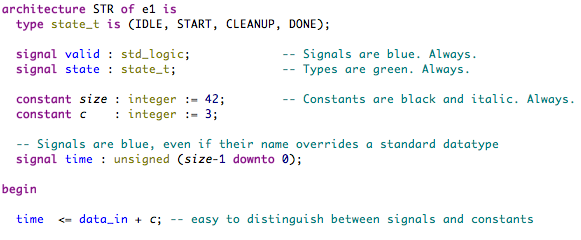In my series of how Sigasi is better than Emacs VHDL mode, I want to talk about code coloring.
Syntax Highlighting
Code coloring consists of two parts: syntax highlighting and semantic highlighting. Most any editor does the former. The keywords are colored, strings, numbers and comments all highlighted in a separate color. All of this is possible using simple regular expressions (regex).
Semantic Highlighting
Semantic highlighting is more difficult. Semantic highlighting means that things get colored according to their meaning, not simply according to their lexical class. Datatypes get a different color from constants and signals get yet another color. In more advanced tools (Eclipse JDT), the same variable will get a different color depending on whether it is written or read. Of course, for any semantic highlighting to work, you need to parse and analyse the file. Short configuration files and regular expressions work great for syntax highlighting, but they fail for semantic highlighting.

Fakin’ It
The Emacs VHDL mode tries to mimic semantic highlighting, as do many general purpose editors. Datatypes are given colored green, but only the standard datatypes. Any datatype that you define yourself is treated as just another “name”. Conversely, if you use the name of a standard datatype and you give a new meaning to it, it will be colored green. Overriding standard names like this is not a smart thing to do, but it is still legal.
I know some engineers who adhere to a coding convention in order to get
code coloring right. Signals end in _s, datatypes end in
_t. This is a workaround. It works fine in the controlled
environment of your own code. But it fails miserably when you have to
inspect or reuse somebody else’s code.

Regex
The case of code coloring illustrates that regular expressions will not cut it any more. This technology has been pushed to its limits in tools like Emacs, with great results. But even the most skilled regular expression wizard has to give up at a certain point, and we’ve reached that point a while ago. In order to move forward and keep improving features like code coloring, regex will no longer serve you well. Built-in parsers are the answer.
See also
- Five reasons why Emacs will always be better (opinion)
- Room for Improvement (opinion)
- Code refactoring: Emacs VHDL mode vs Sigasi (opinion)
- Sigasi Better than Emacs (opinion)
- No VHDL Rename in Emacs VHDL mode (opinion)